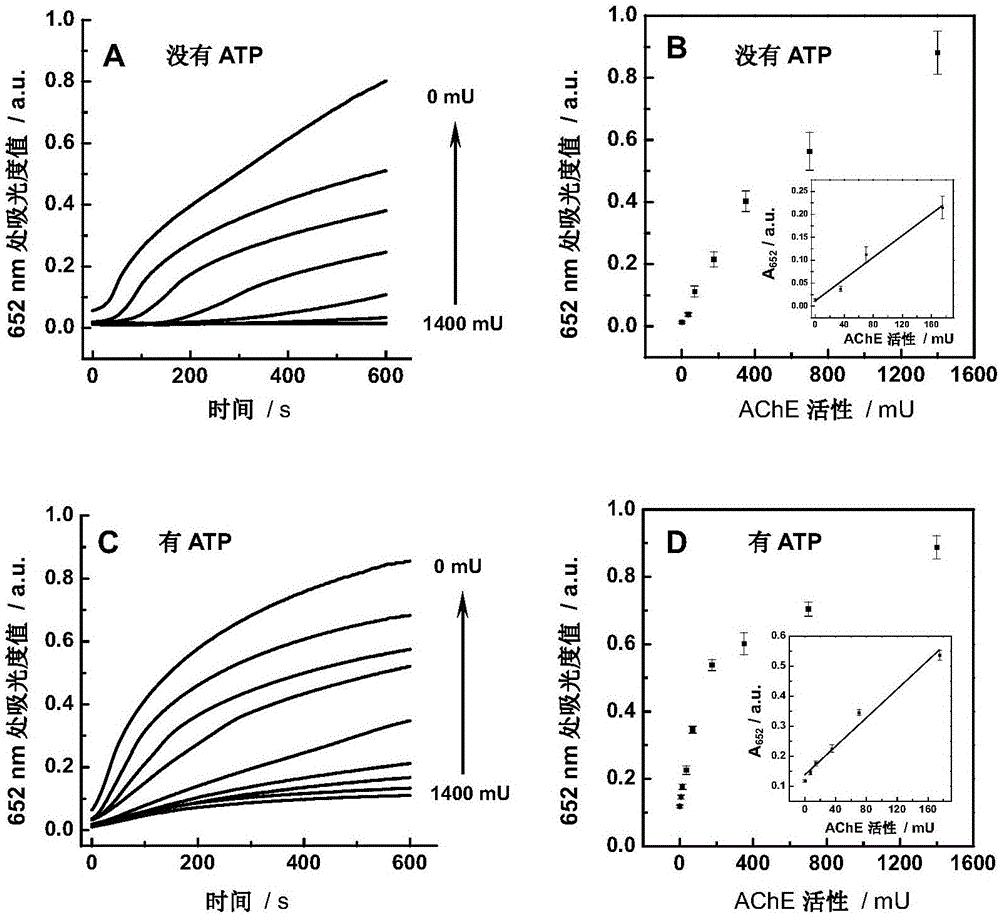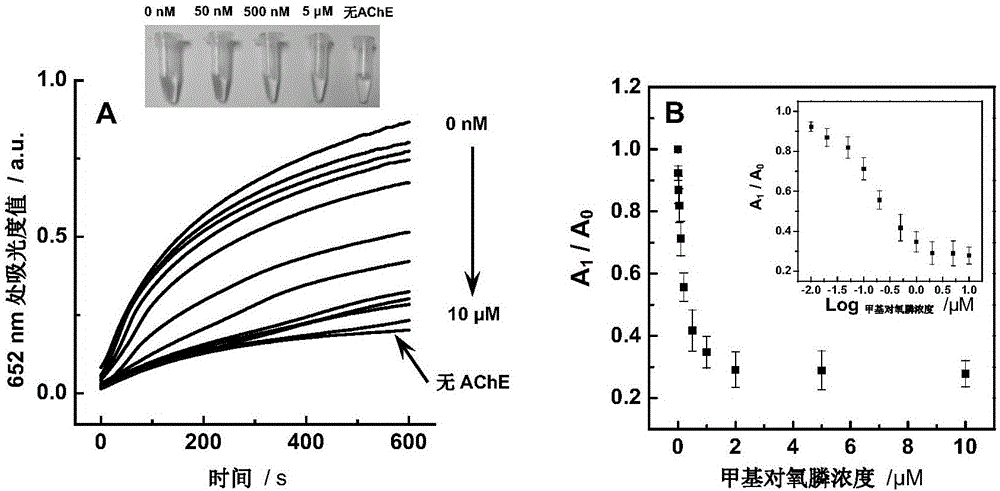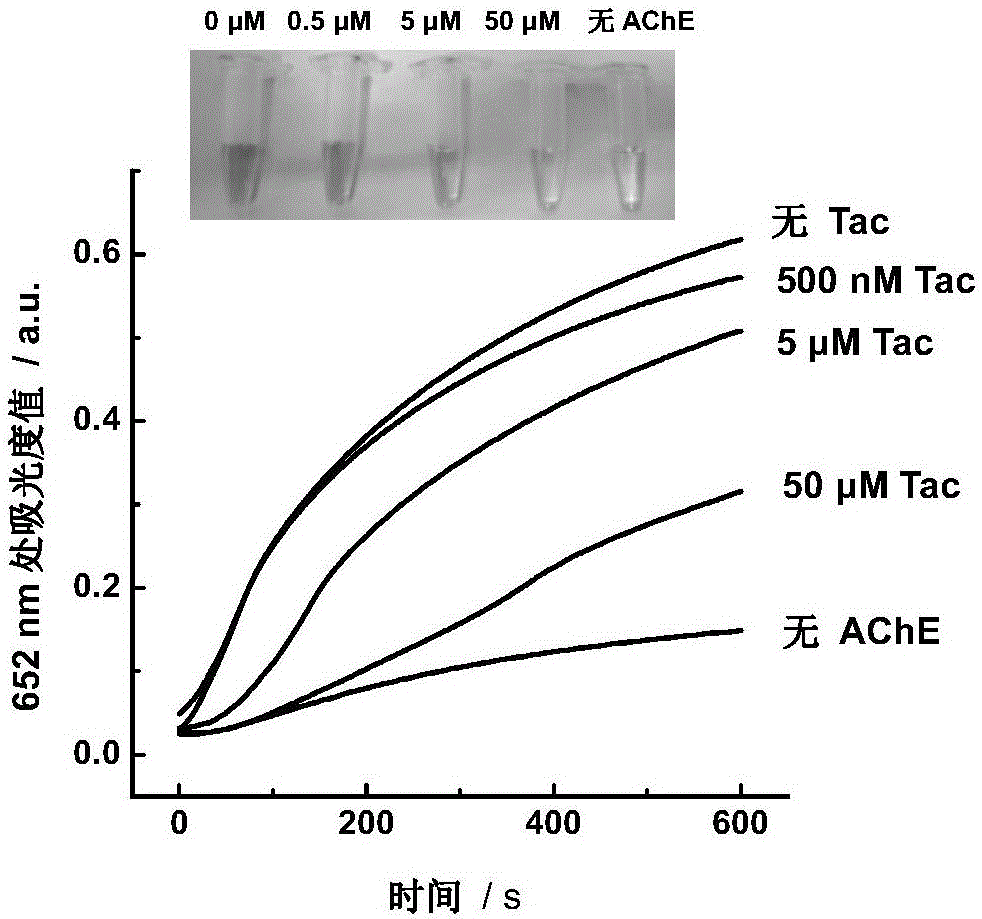Method based on nano mimic enzyme for visually and quickly detecting bio-enzyme, protein and its inhibitor
A technology for detecting biological enzymes and simulating enzymes, applied in the field of biological analysis, can solve the problems of poor sensitivity, complicated operation, long time consumption, etc., and achieve the effects of high sensitivity, good selectivity and easy operation.
- Summary
- Abstract
- Description
- Claims
- Application Information
AI Technical Summary
Problems solved by technology
Method used
Image
Examples
Embodiment 1
[0034] 1) Preparation of nano-mimetic enzyme nanoceria:
[0035] 2.52g Ce(NO 3 ) 3 Dissolve in 100mL of 1:1 mixed solution of water and ethylene glycol, and heat and stir to 60°C. Then, 16 mL of fresh ammonia water was quickly added under stirring conditions, and stirring was continued at 60° C. for 3 hours. The product was centrifuged and successively washed with water and centrifuged 3 times to obtain the crude product of nanoceria. Disperse the nanoceria crude product in 100mL of sodium citrate solution with a concentration of 15mg / mL, and ultrasonicate for 30 minutes. After the nanoceria and sodium citrate have fully reacted, add 100mL of ethanol, stir and centrifuge, and the obtained product is sequentially washed with 1:1 The mixture of water and ethanol was washed and centrifuged three times, and dispersed in pure water. After calculation and measurement, the nanoceria concentration in the dispersion is 14 mg / mL, and the obtained nanoceria dispersion with a concentr...
Embodiment 2
[0039] Example 2 Application of Nano-mimetic Enzyme Technology in the Detection of Acetylcholinesterase Inhibitors Methylphosphine and Tacrine
[0040] First, 1.5U acetylcholinesterase was mixed with different concentrations of methyl-paraphosphine (0, 0.01, 0.02, 0.05, 0.1, 0.2, 0.5, 1, 2, 5, 10 μM) or tacrine (0, 0.5, 5, 50 μM) were mixed with phosphate buffer (pH 7.0) with a concentration of 5 mM to make up to 50 μL, and reacted at room temperature for 30 minutes. After the enzyme activity is fully inhibited, dilute the mixture to 180 μL with 5 mM phosphate buffer (pH 7.0), then add 4 μL TMB solution (25 mM), 2 μL ATP solution (100 mM), 10 μL acetylcholine solution (1.0 M ) and 1.5 μL nanoceria stock solution (14 mg / mL). After mixing evenly, the reagent was placed in a water bath at 37° C. for reaction, and the change of the absorbance value at 652 nm was recorded in real time by an ultraviolet-visible spectrophotometer.
[0041] from figure 2 In A, we can see that with...
Embodiment 3
[0043] Application of embodiment 3 nano-mimetic enzyme technology in urease detection
[0044] Add 4 μL of TMB solution (25 mM), 2 μL of ATP solution (100 mM), 10 μL of urea (1.0M) into 180 μL of the prepared phosphate buffer solution with a concentration of 5 mM and a pH of 4.5, mix well and then add different amounts of urease (0, 7.5, 15, 37, 5, 75, 187.5, 375, 750, 1500mU) and 3μL nanoceria stock solution (2.5mg / mL), after mixing evenly, place the reagent in a water bath at 37°C for reaction, and use UV-Vis The spectrophotometer records the change of the absorbance value at 652nm in real time.
[0045] from Figure 4 It can be seen that in the presence of urease, the absorbance value at 652nm of the detection solution decreases continuously. This is because urease hydrolyzes urea to produce ammonia and consumes H + , the pH of the solution system increased gradually, the catalytic oxidation ability of the nanomimetic enzyme nanoceria was gradually inhibited, and the cat...
PUM
 Login to View More
Login to View More Abstract
Description
Claims
Application Information
 Login to View More
Login to View More - R&D
- Intellectual Property
- Life Sciences
- Materials
- Tech Scout
- Unparalleled Data Quality
- Higher Quality Content
- 60% Fewer Hallucinations
Browse by: Latest US Patents, China's latest patents, Technical Efficacy Thesaurus, Application Domain, Technology Topic, Popular Technical Reports.
© 2025 PatSnap. All rights reserved.Legal|Privacy policy|Modern Slavery Act Transparency Statement|Sitemap|About US| Contact US: help@patsnap.com



